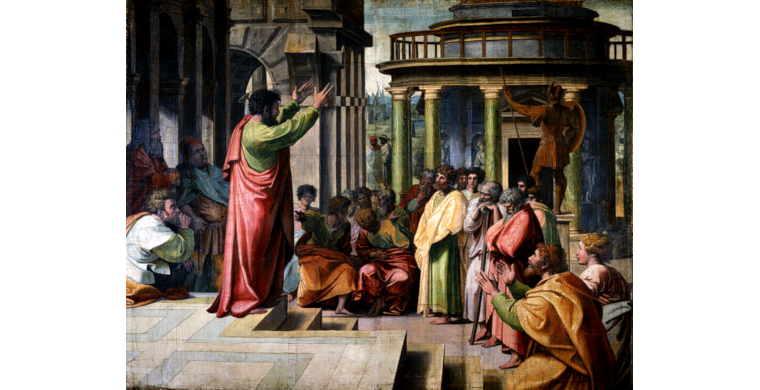CONTEXTUALIZING THE GOSPEL (Part 2)
If we do not contextualize the gospel, we will only beat the air with our words
By David W. Virtue, DD
www.virtueonline.org
February 5, 2024
So Paul stood in the midst of the Areopagus and said, "Men of Athens, I see that you are very religious in all respects. For while I was passing through and examining the objects of your worship, I also found an altar with this inscription, 'TO AN UNKNOWN GOD.' Therefore, what you worship in ignorance, this I proclaim to you. The God who made the world and everything that is in it, since He is Lord of heaven and earth, does not dwell in temples made by hands; nor is He served by human hands, as though He needed anything, since He Himself gives to all people life and breath and all things...Acts 17:22-257
Paul, unlike his predecessors understood that if the content of the gospel was to hit home it had to be understood with the context of his hearers or it would simply make no sense, go over their heads, and fail to hit home.
Paul was an educated Jew, a sharp upgrade on 12 fishermen, the early disciples of Jesus. He would be charged with taking the gospel to the Gentiles and in doing so it demanded that he would need to know who he was talking to, and, while maintaining his complete and total Jewishness, erudite pedagogical learning and birth, he would have to adapt all his learning to his audience within the context of his hearers.
The above incident on Mars Hill is a case in point. He talks about God, not Jesus, not the power of the Holy Spirit, but simply God, the unknown god of the pagan world that he would now reveal to them who He was. It was where he addressed the religious idolatry of the Greeks who even had an altar to the "Unknown God."
It was this altar and their religious idolatry that Paul used as a starting point in proclaiming to them the one true God and how they could be reconciled to Him.
Paul's sermon is a classic example of a gospel presentation that begins where the listeners are and then presents the gospel message in a logical and biblical fashion. In many ways it is a classic example of apologetics in action. Paul started his message by addressing the false beliefs of those gathered there that day and then used those beliefs as a way of presenting the gospel message to them.
It was the gospel in context.
We know that when Paul arrived in Athens, he found a city "given over to idols" (Acts 17:16). In his usual manner, Paul began presenting the gospel to both Jews and Gentiles. He started by "reasoning in the synagogue with the Jews and with the Gentile worshipers" (Acts 17:17) and then also proclaimed the gospel "in the marketplace daily with those who happened to be there" (Acts 17:17).
While at the marketplace he encountered some Epicurean and Stoic philosophers (Acts 17:18) who, having heard Paul proclaim the resurrected Jesus Christ, wanted to learn about "this new doctrine" he was teaching, so they "brought him to the Areopagus" to hear more from him (Acts 17:19--20).
We know from history that the Epicurean philosophers generally believed that God existed but that He was not interested or involved with humanity and that the main purpose of life was pleasure. On the other hand, the Stoic philosophers had the worldview that "God was the world's soul" and that the goal of life was "to rise above all things" so that one showed no emotional response to either pain or pleasure.
These groups and others with their dramatically opposing worldviews loved to discuss and debate philosophy and religion. Intrigued by what they considered Paul's "babblings" about the resurrection of Christ, they brought him to the Areopagus where the Athenians and foreigners "spent their time in nothing else but to tell or hear some new thing" (Acts 17:21).
As mentioned earlier, Paul's presentation of the gospel is a great example for us, both as a pattern for how Paul identified with his audience and as an example of apologetics in action. His connection with his audience is seen in how he begins addressing those gathered at the Areopagus. He begins with the observation that they were "very religious," based on the fact that they had many altars and "objects of worship" (Acts 17:23) including an altar to "the Unknown God." Paul uses that altar to introduce them to the one true God and the only way of salvation, Jesus Christ.
His apologetic method and his knowledge that they did not even know what God is really like leads him to go back to Genesis and to the beginning of creation.
Having a completely wrong view of God, those gathered that day needed to hear what God really was like before they would understand the message of the gospel. Paul begins explaining to them the sovereign God who created all things and gives life and breath to all things. He continues to explain that it was God who created from one individual all men and nations and even appointed the time and boundaries of their dwelling (Acts 17:26). His message continues as he explains the closeness of God and their need to repent of their rebellion against Him. Paul completes his message by introducing them to the One before whom they would all stand one day and be judged--Jesus Christ, whom God had raised from the dead.
In Part 3, I will explore Paul's contextual apologetics as they are seen in his various letters.














